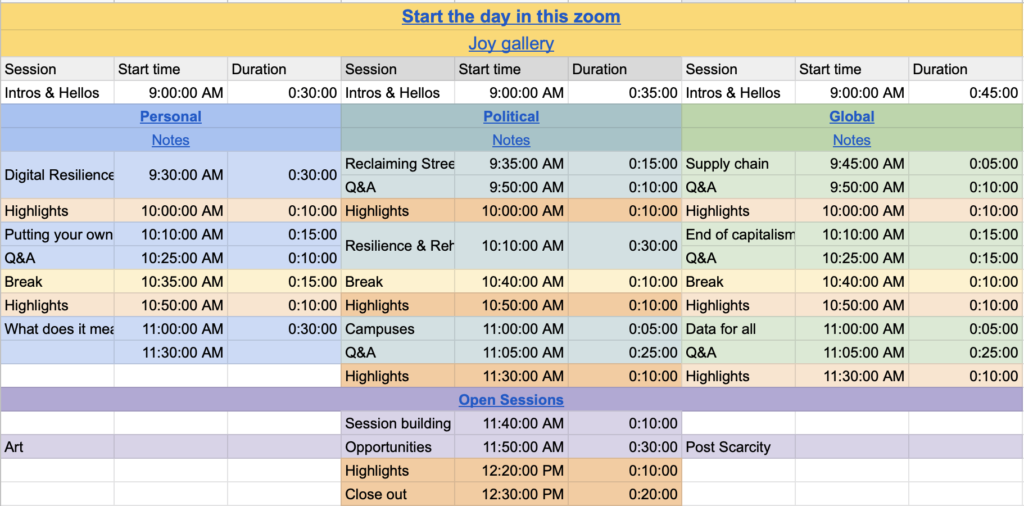I was pretty sure it was going to be a disaster the day before. Hell, the week before. Having multiple tracks of participatory sessions meant that people would need to move from video conference link to video conference link. We didn’t have a shared chat space consistent across all the “rooms,” and I was anxious to go to other links myself to gather people, leaving the core room unattended.
It could have been terrible. Instead, RecoveryCon was a smashing success, with people joining from all over the US, plus the UK, Germany, and Turkey. We ran (mostly) on time. We shared back what had happened in sessions. We cried a bit together. And we ended 3 minutes early.
Another blog post will happen soon with a summary of sessions, links to notes, and our Joy Gallery; but for now I wanted to tell you about facilitating a multi-track open-spaces style event. A caveat that a high proportion of my friends are facilitators and/or are tech savvy. YMMV.
The logistics
We had as many video conference “rooms” as we had tracks. This will come into play with the agenda. One “room” should be both a track and also where you start / regroup to. This means anyone coming to the conference at weird times is swept up in a session without extra overhead. It also gives a consistent sense of a “common room” that people know to go to if they get lost or booted or whatever.
Start a notes doc for each track, including headers for each session and reminders of when to come back to the main room. That way, folk don’t need to ask about it. It will be a bit of a Thing when times change and you have to go update each doc, but oftentimes folk will have already updated it for you. You will be able to see this in the notes doc when the content overview post goes up.
If I were going to do this again, I would have a chat of some kind with the session leads and facilitators to coordinate and remind about coming back. This time it worked out great, tho!
The agenda
This was bananas to me. I am in the school of facilitation that does not share the agenda for an event, but rather encourages people to be fully present by asking them to trust me and giving folk whatever comes next as it happens. This time, I shared a spreadsheet of when various things were going to happen. This spreadsheet also provided a source of truth so far as links to video conference rooms and notes docs so folk could self-sort.

All sessions ended up being the same length of time, which was different than originally planned. I tried to add in complexity where it wasn’t needed, and we organically got back to a simpler state.
Expectation setting
In addition to a version of the participant guidelines from Aspiration I give (and was reminded to do so this time — thank you), we also had the expectation of all watching the clock together, and of returning to the main room. I asked at least once on each front for those to be repeated back to me, and made the main room clear in the communications emails sent out to attendees.
We also set the expectation of collaborative note taking as active listening and of reporting back on sessions so folk who went elsewhere still felt like they got something out of the sessions they missed.
Thank you
Thank you to all the amazing folk who came to RecoveryCon and made it what it was. Special shout out to Greg, for helping with organizing; to Liz, for having boundaries; to Adrienne and Heather for facilitating tracks; and to Cheryl, Beatriz, Nathan, sevine, Julie, Courtney, Lou, Ahmet, B, and two other folk I missed for leading sessions.
